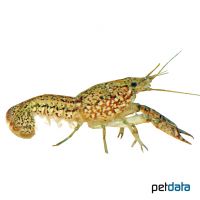Slough Crayfish (Procambarus fallax)
| Slough Crayfish Procambarus fallax | |
|---|---|
| Name | Slough Crayfish |
| Name Lat. | Procambarus fallax |
| Family | Freshwater Crayfish |
| Family lat. | Cambaridae |
| Order | Decapoda |
| Order lat. | Decapoda |
| Origin | North America |
| Habitat | Streams, ponds, swamps |
| Diet | Carrion, leaves, crayfish food |
| pH | 6.5-8.0 |
| Behavior | Semi-aggressive |
| Keeping | Individual, pair, group |
| Care Level | Moderate |
| Reproduction | Egg layer |
| Breeding | Moderately difficult |
| Life Span | 3-6 years |
| Protection | No |
| Metric Units | |
| Size | 7-10 cm |
| Temperature | 15-27 °C |
| Hardness | 5-15 °dH |
| Aquarium | ~ 50 l |
| US Units | |
| Size | 2.8"-3.9" |
| Temperature | 59-81 °F |
| Hardness | 89-267 ppm |
| Aquarium | ~ 15 gal |
Distribution and habitat
Everglades swamp crayfish are widely distributed in southern Florida. There they live in slow-moving and stagnant waters, such as small rivers, streams, ponds, pools and irrigation ditches with dense vegetation.
Maintenance
They need a well-structured aquarium with roots, stones and robust plants, with hiding places (caves, crab tubes) and a moderate current. The substrate should be sand or gravel, partially covered with foliage (e.g. sea almond leaves, oak leaves).
No ammonia, ammonium and nitrite should be detectable in the aquarium water, the nitrate value should not exceed 100 mg/l. To ensure water quality and oxygen content, a filter and heater adapted to the size of the aquarium is required, as well as lighting for the species-appropriate day-night rhythm of the animals. When choosing the filter, special care should be taken to ensure that the animals cannot be sucked in.
Diet
They feed on animal organisms, carrion and dead plant material. They prefer live food, such as daphnia, artemia and fish, which is also accepted in frozen form, as well as foliage (e.g. oak, beech, maple, birch), food tablets, granulated and flake food. Occasionally, vegetable food in the form of spirulina, kelp or scalded leafy vegetables should be offered.
Regular and varied feeding promotes health and prevents deficiency symptoms. Unaccepted food must be removed after 2-3 hours.
Behaviour and compatibility
They hardly behave aggressively within the species, but also towards other crayfish. Keeping several pairs or groups is only recommended in a much larger and richly structured tank. They can be socialized with shrimps, snails and peaceful fish, but it is better to keep them in a species tank.
Basically, only compatible animals with similar demands on water condition and water temperature should be socialized.
Reproduction and breeding
Males can be identified by the pointed claws and the gonopods (mating styli) on the abdomen of the underside of the body. Males have 3 swimming legs, females 5. During mating, the male turns the female onto her back shortly after her molt and transfers a sperm package with his gonopods. The female carries the eggs (30-40 of them) on her pleopods (webbed feet) and supplies them with oxygen by movement (fanning). Dead or non-developing eggs are eaten by the female. The young hatch after about 4 weeks.
Important
Attention: EU-DVO 2016/1141 Invasive species
They do not have special requirements for water quality and can stay on land for a long period of time (semiterrestrial). It may happen that an Everglades swamp crayfish is missing a claw. This is usually females that have lost a claw during mating. The missing claw slowly grows back during subsequent molts.
As the foliage (e.g., sea almond or oak) rots, it promotes the development of microorganisms that provide a valuable secondary food source.
The well-being of the animals should be monitored regularly. Temperature should be checked daily, pH, hardness and nitrate levels at least every 14 days. Regular partial water changes are recommended, even when contaminant levels have not yet reached the upper limit. Sudden changes in water quality should be avoided. Newly introduced animals must be accustomed slowly to the water in the aquarium.
Further literature can be found in your pet store.
References
Text: Barbara Pachner; Image: petdata
Source: LUKHAUP & PEKNY (2008): Süßwasserkrebse aus aller Welt, Dähne Verlag; ENGELMANN & LANGE (2011): Zootierhaltung - Tiere in menschlicher Obhut: Wirbellose, Verlag Harri Deutsch
